| Pages:
1
2
3
4
5
6
..
13 |
jdowning
Oud Junkie
    
Posts: 3485
Registered: 8-2-2006
Location: Ontario, Canada
Member Is Offline
Mood: No Mood
|
|
On the twisting rig it became immediately apparent that the sericin residues were preventing each thread bundle from being smoothly twisted -
producing a rather 'bumpy' string. It should be noted, however, that the thread bundles were being twisted dry whereas if the string had been
moistened first this would have softened the sericin sufficiently to allow the threads to slide over each other to make a smoother string (this is the
old Chinese method for making strings from raw silk)
The 16 thread bundle was loaded with a 240 gram weight and the 64 thread bundle with a 960 gram weight (4X240). As twisting progressed there came a
point when the tension of twisting in each bundle overcame the weight load the bundle then suddenly winding around itself like a spring. Lets call
this 'corkscrewing' for want of a better term. This is the point of maximum possible twist.
The attached image shows the start of corkscrewing in the 16 thread bundle. Twisting then proceeded further until the thread bundle eventually broke
under the strain. The 64 thread bundle was tested in the same manner until it became impossible to control further twisting and take measurements.
This thread bundle did not break.
The attached plots C and D show the measured contraction of each bundle against the number of turns. For information, the minimum and maximum twist
values calculated using the Rakov formula have been superimposed.
Plot C also includes Plot B for comparison suggesting that the the fully degummed silk thread bundle used for the Plot B trial is significantlyweaker
than that of the partially degummed thread bundle. This again suggests that the degumming procedure needs further refinement in order to maximise the
strength of the silk threads.
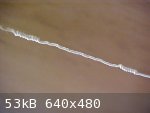


|
|
|
jdowning
Oud Junkie
    
Posts: 3485
Registered: 8-2-2006
Location: Ontario, Canada
Member Is Offline
Mood: No Mood
|
|
To complete the picture for this part of the trials, the attached image shows the 64 thread bundle in its uniformly 'corkscrewed' state - much shorter
than the free length of the original thread bundle. The thread bundle in this state is quite elastic, like a spring, returning to its original state
when stretched. The diameter has also increased. I unfortunately forgot to measure the diameter before unwinding the bundle but from the image it can
be estimated that the diameter is about 80% greater than the simply twisted (uncorkscrewed string).
Could this construction be made into a viable bass string after being stabilised with a Gum Arabic coating (if the tension is released the string
would otherwise unwind of its own accord)? Something to investigate further perhaps.
Allowing the thread bundle to unwind after all this abuse reveals that the silk threads have been permanently distorted beyond their elastic limit -
looking a bit like wool from a Merino sheep! The' non woolly' bits are places where the sericin remained after degumming.
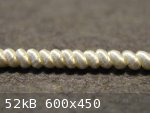
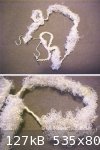
|
|
|
jdowning
Oud Junkie
    
Posts: 3485
Registered: 8-2-2006
Location: Ontario, Canada
Member Is Offline
Mood: No Mood
|
|
Silk supplied as a skein must be mounted on a 'skein winder' so that the silk threads may be unwound without becoming entangled. The loops of the
skein - as received from the supplier - are loosely tied and the free ends identified with a short piece of single and double thread.
The silk thread is finer than a human hair and stronger than steel (of the same diameter) - nevertheless careful handling is necessary to avoid
breaking the thread.
The 'skein winder' has been made from scrap material. The arms are made from pine and set at a slight angle from the hub so that tension is applied to
the string skein supports that may be readily adjusted to accommodate the skein diameter.
The intent is to feed the silk filament directly from the skein winder to the string winder and eliminate the unnecessary step of winding the silk
first on to a bobbin.
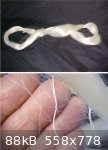

|
|
|
jdowning
Oud Junkie
    
Posts: 3485
Registered: 8-2-2006
Location: Ontario, Canada
Member Is Offline
Mood: No Mood
|
|
With the skein mounted on the winder there is some concern about the loose threads remaining 'dangling' after the skein has been fully tensioned. The
two free ends of the skein appear to start to tangle in one spot and do not seem to run freely off the winder as expected. However, it is important to
select the correct free end - the end that runs from the outside of the skein. Due to twisting of the skein (?), some manipulation of the skein on the
winder was first necessary to free the thread from tangling - although it seemed to still temporarily stick in places. As the thread will be fed
directly onto the string winder - the whole thing being wound slowly by hand - it is hoped that sufficient control will be maintained to avoid thread
breakage.
With the rig set up on the workshop bench, winding a 16 strand 'Hadd' as a test went without a problem. So far so good! With 8 turns of the silk
thread on the winder, the two free ends are tied together to complete the thread bundle. Before removing the thread bundle from the winder, two
opposite ends are formed into loops (tied with cotton thread) required to hold the retaining hooks during the thread bundle twisting operation.
The skein is labeled with Chinese characters on one side (I don't know what they mean) and the number 40/44 that I take to be the denier measure
(weight in grams per 9000 metres). This is given being between 40 and 44 denier - a standard tolerance for the silk industry.
A short, 16 thread, test string was made up and the diameter measured at about 0.37 mm using a dial caliper (difficult to be precise due to the
relative softness of the silk). This should be about the required diameter for a 'Hadd' string but will be confirmed, one way or another, after making
and testing a few strings. If the string diameter turns out to be a bit too small, then a proportionally greater number of silk threads may be used
for each string bundle to make slightly thicker strings.
Under magnification, it appears that the silk thread is 'raw' - that is the Sericin gum has not been removed. The easiest and most efficient procedure
would be to de-gum the whole skein prior to making up the string bundles. However, it has been decided - for the purposes of these trials - to de-gum
each thread bundle individually prior to twisting. This way will minimise the risk of losing the whole skein should there be thread entanglement
during the de-gumming operation.
All a bit slow and tedious but this is not intended to be a production string making process at this stage.

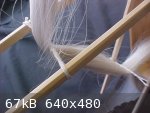
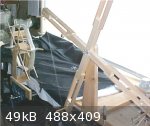
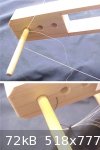
|
|
|
jdowning
Oud Junkie
    
Posts: 3485
Registered: 8-2-2006
Location: Ontario, Canada
Member Is Offline
Mood: No Mood
|
|
Silk filament, after removal of the protective gum coating (Sericin), will readily absorbs dyes and the chemicals used in the dying process, necessary
to 'fix' the colours and make the colours brighter and permanent (mordants).
The mordants for natural vegetable dyes range from tartaric acid to heavy metal salts. Heavy metal salts have also been used to add weight to silk
filament - silk always being sold by weight - more weight equals greater market value. Removal of the Sericin gum reduces the weight of silk filament
by 20 -25% so the silk industry accepts the restoration of the weight lost by de-gumming by artificial 'weighting' as legitimate. However, as it is
possible to increase the weight of silk, using heavy metal salts, far beyond the 20% or so lost in de-gumming, the mal-practice of 'over weighting'
had its commercial attraction. For example, in recent history, much silk coming from China was at one time 'weighted' with the heavy metal salt lead
acetate (poison!) - a practice now, thankfully, discontinued.
Why is excessive 'weighting' of silk considered to be an industrial mal-practice? The metal salts (and the process of weighting) cause degradation of
the silk Fibroin protein so that the silk not only will lose strength but will relatively quickly 'auto destruct' and fall to pieces - even if kept in
storage.
This is a big topic so more to follow!
|
|
|
jdowning
Oud Junkie
    
Posts: 3485
Registered: 8-2-2006
Location: Ontario, Canada
Member Is Offline
Mood: No Mood
|
|
Why would a heavier silk filament be of interest to a maker of silk musical instrument strings?
From the so called Mersenne vibrating string relationship - if all else, string length, tension, flexibility etc. remain unchanged - adding linear
mass or weight to a string lowers the vibrating frequency of a string. This is an important consideration in the quest for making viable, larger
diameter, bass strings, that sound well and in tune.
Since their invention in the late 17th C and until the present day, a significantly increased linear mass has been provided by winding metal wire
around a thin flexible core of silk filament or gut - core materials later to be replaced by nylon filament ( the modern over spun bass string
familiar to all).
This was not an option available (or perhaps not an acceptable option) to the early string makers but 'loading' or 'weighting' of the silk string
material to produce a better bass string response and sustain may have been (?).
What is the sustain of a bass string that we are looking for here. According to Marin Mersenne, writing in the early 16th C , the thickest bass string
of a 10 course lute of his era (gut - or silk perhaps?), had an audible sustain of up to 20 seconds (compare that to the sustain of a modern metal
overspun string!). High standards indeed!
Is it possible for weighted silk (or gut) bass strings to achieve this level of performance? Only one way to find out - although, historically, the
task for oud strings should be much less complicated in that the thickest bass string under investigation (for this project) is that for a 5 course
oud.
|
|
|
jdowning
Oud Junkie
    
Posts: 3485
Registered: 8-2-2006
Location: Ontario, Canada
Member Is Offline
Mood: No Mood
|
|
The earliest Chinese text on making silk strings (the Taiyin Daquanji) dates from the 15th C but makes reference to much earlier periods.
This document makes it clear that silk instrument strings should not be made from
" cocoons that have salt mixed in".
The English translation on John Thompson's website goes further " Nowadays people often use cocoons with salt mixed in - perhaps coming from a desire
to make the nature of the silk more coarse and so emphasises marketability but, using this kind of silk makes strings which are brittle and easy to
break. And when a dark and rainy day comes, the strings become damp and do not resound. The nature of the salt causes this"
I interpret 'coarse' in this context to mean 'heavy'. What is 'salt'? It might be common table salt (Sodium Chloride) but could well be other
metallic salts (Aluminium, Tin, Lead etc.) in common use at the time.
|
|
|
jdowning
Oud Junkie
    
Posts: 3485
Registered: 8-2-2006
Location: Ontario, Canada
Member Is Offline
Mood: No Mood
|
|
The Chinese made their strings from raw silk filament (i.e. with the Sericin gum coating left intact). Prior to twisting the strings, the silk
filaments were soaked in water to soften the Sericin and the strings twisted when humidity was high. The twisted strings were then boiled in a glue
concoction of isinglas (Sturgeon fish glue), wheat starch and other materials for a specific period of time and then stretched out to dry. The glue
binds the filaments of the string firmly together into a uniform whole and provides additional linear mass to the string supplementing the weight
already provided by the Sericin (about 25% of the raw silk weight).
The instructions for making oud strings in the 14th C Kanz al-tuhaf on the other hand clearly starts with degummed silk filament - the Sericin being
removed by boiling in water with wood ash added. While this procedure likely did not remove all of the Sercin, it would have significantly reduced the
linear mass of the completed string - an apparent disadvantage - and risked weakening the silk if boiled for too long in too strong a wood ash
solution. Yet, apparently, there is no mention of any attempt to replace the weight lost by removal of the Sericin - except for the additional weight
provided by the Gum Arabic glue used as a binder.
|
|
|
jdowning
Oud Junkie
    
Posts: 3485
Registered: 8-2-2006
Location: Ontario, Canada
Member Is Offline
Mood: No Mood
|
|
Ziryab - at the court of Khalif Harun (early 9th C) - is recorded as being credited with being the first to use silk strings on his oud (he also used
gut strings). According to Farmer's translation of the meagre surviving accounts - the silk strings "were not spun in hot water as was the custom".
Also Zyryab's strings (silk?) were colour coded - the treble zir (yellow), mathna (red), mathlath (white) and the bass bamm (black). (Ziryab also is
credited with introducing a fifth string, between the mathlath and mathna courses, but no colour is given for this).
What does "not spun in hot water" mean? The oud silk string making technology (and sericulture) likely came from the Chinese via Persia so the
"established custom", presumably, was to make the strings from raw silk (with the Sericin intact) - the twisted strings then being treated "in hot
water" (i.e. boiled in a glue concoction).
Zyryab's strings, however, were made differently - i.e. not according to previous custom or tradition. If they were not "spun in hot water" then
perhaps cold water may have been the alternative?
A clue to the difference may be in the colouring of the strings - presumably with natural dyes absorbed into the silk producing translucent colours
(rather than natural earth 'paints' that coat only the exterior surfaces producing opaque colours).
Silk filament is an absorbent material that readily accepts dye colours (as well as other chemicals) - the process for dyeing silk being ancient
technology. Natural dyes, often derived from vegetable sources, will fade over time unless chemically 'fixed' and made more brilliant with a
'mordant'
More to follow.
|
|
|
jdowning
Oud Junkie
    
Posts: 3485
Registered: 8-2-2006
Location: Ontario, Canada
Member Is Offline
Mood: No Mood
|
|
Mordants traditionally used by the dyeing industry to fix the colours of the natural dyes range include the more common mordants such as Alum, Tannin,
and heavy metal salts such as (iron) ferrous sulphate, (tin) stannous chloride as well as the more toxic salts of lead and mercury. These mordants,
when absorbed by the fibres under treatment - silk, wool cotton etc - increase their weight.
Tannin (or Tannic acid) has an affinity for metallic salts so that pre treatment of silk filament with this chemical will ensure better absorption of
metallic salts as a secondary treatment prior to dyeing the silk. Treatment with Tannin alone can replace the 25% loss of weight (due to removal of
the Sericin) without detriment to the silk filament (Fibroin). The metal salt mordants can then further increase the weight of the silk prior to
application of the dye colour.
|
|
|
jdowning
Oud Junkie
    
Posts: 3485
Registered: 8-2-2006
Location: Ontario, Canada
Member Is Offline
Mood: No Mood
|
|
It is the usual practice in the textile dyeing industry to remove the Sericin coating entirely before application of the mordants and dye. This is
presumably to ensure maximum penetration of the dye by adsorption by the Fibroin. Degumming of the raw silk is usually accomplished commercially by
soaking in a hot alkaline solution with the addition of soap.
However, acid solutions will also dissolve the Sericin (even pure water will remove about 5% by weight). Low strength acids will also remove the
sericin without attacking the Fibroin.
Tannic acid (Tannin in solution) may be adsorbed by the Fibroin by up to 25% in a hot solution and by a considerable amount even in a cold
solution.
Furthermore, it would appear that it is not necessary to remove the Sericin in order for the mordant salts or acids to be adsorbed (the ancient
Chinese even increased the weight of cocoons with salt without need for degumming). One source gives an example of a pound of raw silk that will
adsorb half a pound of Tannin without the silk being changed in character and that a pound of silk so loaded with Tannin can then adsorb an additional
half a pound of an iron salt without adverse effect. By adding more mordant chemicals, the total weight of a pound of silk might be increased to 3 or
4 pounds (and in some experiments has been increased to 9 pounds!). Silk given a black dye will stand more weighting than silk with a lighter coloured
dye.
So the possibility that Ziryab's dyed oud strings may have been weighted with mordant chemicals applied in cold solution is a possibility worth
testing as part of this investigation.
A modest doubling of the linear weight of a string will - according to the Mersenne-Taylor law for a vibrating string - lower the frequency of
vibration by about 30% (string diameter, length, and tension remaining unchanged). So this is a target weight increase worth aiming for - particularly
for the thicker bass strings.
Next - to review the materials required for weighting the silk strings in the context of this investigation where only chemicals that would have been
available to silk string makers in the 9th C can be considered.
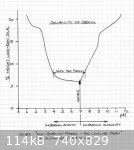
|
|
|
jdowning
Oud Junkie
    
Posts: 3485
Registered: 8-2-2006
Location: Ontario, Canada
Member Is Offline
Mood: No Mood
|
|
Renowned scholar (and genius?) Abu Musa Jabir ibn Hayyan al azdi
(Arab/Persian? - born c. 721, died c. 815) - known as "Geber" in Medieval Europe - is most famous for his contributions to experimental chemistry. He
said that "The first essential in chemistry is that you should perform practical work and conduct experiments, for he who performs not practical work
nor makes experiments will never attain the least degree of mastery".
Jabir is credited with the discovery and description of the now commonplace chemical substances - hydrochloric, nitric and sulfuric acids - as well as
'aqua regia' (capable of dissolving gold - particularly important for dreams, and despair, of the alchemists!).
He is also credited with the discovery of citric acid, acetic acid (from wine vinegar) and tartaric acid (from red wine), the distillation of alcohol
from wine and use of Alum as a mordant for dyeing fabrics.
Many of the substances of interest to this investigation pre-date the work (or record?) of Jabir. For example the heavy metals iron, tin, lead and
mercury and their salts, organic acids such as tannic acid (tannin - used for treatment of leather), wine vinegar, tartaric acid and cream of tartar
etc. were familiar to earlier civilisations.
Do not under- estimate the extensive knowledge of the ancients!
Apologies for presenting this continuing thread in bits and pieces as time permits (a busy time of year for me). More to follow!
|
|
|
jdowning
Oud Junkie
    
Posts: 3485
Registered: 8-2-2006
Location: Ontario, Canada
Member Is Offline
Mood: No Mood
|
|
Materials that qualify for consideration in this experimental investigation of silk string weighting include Tannin (Tannic acid) and metal salts Alum
(Aluminium), Ferrous Sulphate (Iron), Stannous Chloride (Tin) and Lead Acetate. Also, in order to control the acidity of the mordant/weighting
solutions to within acceptable levels (low acidity), buffering additives such as Citric Acid or Tartaric Acid will likely have to be employed. All of
these materials were known to the ancients (some materials even predating Jabir ibn Hayyan's discoveries) and are still used today as mordants in the
dyeing of silk filament as well as for weighting silk.
The denser heavy metal salts should potentially produce the greatest weight additions, however, Lead Acetate will not be used as it is an insidious
poison (although likely less of a danger when adsorbed into an instrument string and sealed in place with a glue or varnish binder).
Stannous Chloride may be purchased from some suppliers dealing with fabric dyes but other suppliers will not carry it because of its toxicity (less
than lead however).
Alum is readily available and safe to handle and is widely used as a dye mordant but with a density less than that of raw silk is unlikely to be of
any use as a weighting agent so is discounted for these trials.
Ferrous Sulphate, like Alum is used both as a mordant and weighting salt and is considered safe to use and readily available.
Tannic acid is widely used as a safe mordant (or pre-mordant conditioner). It is readily adsorbed by silk filament so can also be considered as a
weighting agent.
In order to limit the possible variables for these experiments, Tannic Acid and Ferrous Sulphate will be tested as weighting agents - employed in
separate weighting solutions. The acidity of the solutions will be controlled to around pH 4 at room temperature using buffers as necessary. This will
partially dissolve and soften the Sericin (and, hopefully, allow the salts to penetrate the silk Fibroin) as well as retaining a portion of the weight
of the Sericin.
As a Stannous Chloride can be made by dissolving the pure metal Tin in concentrated Hydrochloric Acid, a small sample will be made up for testing.
The dyeing of the silk is incidental to the weighting process so could be omitted. However, as the extent of penetration of a dye into the silk might
reveal some useful information, the test strings will also be dyed with a natural dye after being weighted.
It should be noted that weighting solutions are considerably more concentrated that those used only as a dye mordant. As information on the precise
procedure for weighting silk is hard to find (probably classed as a 'trade secret' by the industry) the solutions used in these trials will initially
be made at maximum concentration (saturated solutions), the adsorption of the salts being controlled by time of immersion in the weighting solutions.
|
|
|
jdowning
Oud Junkie
    
Posts: 3485
Registered: 8-2-2006
Location: Ontario, Canada
Member Is Offline
Mood: No Mood
|
|
While searching for the best source of mordants/natural dyes, an experiment to make Stannous Chloride has been tried.
The preparation of the salt is basically straightforward but was found to be somewhat slow and tedious. For convenience lead free solder (95% Tin 5%
silver) - available from any hardware store - was cut into small pieces (the smaller the better). Commercial strength (32%) Hydrochloric Acid -
available from hardware stores for cleaning stone and brick work - was added (10 ml) to the Tin in a test tube. The acid reacts readily with the Tin
to form a solution of Stannous Chloride and Hydrogen gas is given off. Tin was added little by little until no more would dissolve.
To speed up the process, the test tube was immersed in a water bath maintained at a temperature of 90 Celsius. Nevertheless it took several hours to
complete the task with about 4 grams of tin being dissolved in 10 ml of acid.
The resulting clear liquid has been stored with excess undissolved tin in case there is any further delayed reaction.
The solution is strongly acid (about pH 1 or 2 measured with litmus test papers) so will have to be used with a buffer solution to reduce the acidity
to a level where the silk Fibroin will not be damaged.
As commercially prepared Stannous Chloride in powder form is relatively inexpensive, a small quantity (100 grams) will be purchased for test purposes
along with the Tannin and the other chemicals needed for the trials.

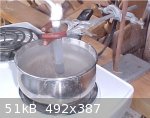
|
|
|
jdowning
Oud Junkie
    
Posts: 3485
Registered: 8-2-2006
Location: Ontario, Canada
Member Is Offline
Mood: No Mood
|
|
Work on silk string making is currently temporarily 'on hold' due to life's other priorities at this time of year.
However, 'Treenway Silks' has a clearance sale and is selling a 200 gram cone of 120/2 spun silk yarn at 50% off regular price for $23.80 (plus
shipping and handling). Each cone carries 13,000 yards of silk yarn (about 12 kilometers). I could not resist purchasing a sample for testing!
Spun silk is made by spinning relatively short lengths of silk filaments (from 'scrap' cocoon silk or perforated cocoons) into a thicker strand
(unlike reeled silk where a strand is made from a continuous cocoon filament).
Spun silk yarns are made by then twisting the spun strands together - used primarily for weaving into silk fabrics. The industrial standard 120 (e.p.i
or ends per inch) means that if 120 yarns are laid side by side they will measure an inch across (25.4 mm). So 120/2 is a relatively fine yarn
composed of 2 spun strands twisted together to make the yarn (a stable assembly of silk fibres).
The question of interest here is can spun silk yarn be used to make functional silk strings?
How strong is the yarn - its breaking strength etc. Only one way to find out!
A macro image of the yarn shows its two strand twisted construction as well as its (less than ideal) 'hairiness'- not a problem for weavers of silk
fabric but what about silk string makers?
A test string was quickly made by simply twisting 16 yarns together, 175 turns under a load of 240 grams (as for the experimental Hadd strings). The
175 turns was found to be the maximum degree of twist before the string began to lose its regular uniform cylindrical shape.
The string - still under load - was then coated with Gum Arabic to bind the silk fibres into a stable uniform string.
Some 'hairiness' remained so the string was then polished using a very fine abrasive (industrial grade 'rotten stone' ) on a cotton rag followed by
another coating of Gum Arabic . This treatment resulted in quite a smooth and uniform string measuring 0.54 mm in diameter. (see attached macro
image).
Due to its multi strand construction, the string is quite flexible compared to one made from simply twisted reeled silk filament - and the yarn,
conveniently wound on a cone, is easier than reeled silk filament to handle as well.
A section of the sample string was then subjected to destructive testing - failing under a load of about 6 Kg - more than adequate.
The remaining length of string will now be tested on a lute to see how it performs.
If the spun silk does not perform well as a simply twisted string material it may well have a practical application for over spinning on a core of
reeled silk filament to make.
More to follow later as time permits
Edited to correct the length of spun silk on the 200 gram cone - 13,000 yards (about 12 kilometers) not 1,200 yards as advertised.
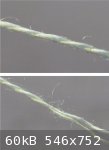
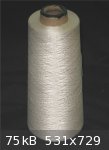
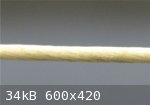
|
|
|
jdowning
Oud Junkie
    
Posts: 3485
Registered: 8-2-2006
Location: Ontario, Canada
Member Is Offline
Mood: No Mood
|
|
For a quick test and assessment the spun silk string has been mounted - for convenience - in place of the top string of my 'Hieber' lute (but tuned to
the second course pitch C# @A440).
The string took a while to 'settle down' but sounded quite well - with good 'bright' tone and sustain - comparable to the second course PVF strings on
the lute.
This hastily made string is not quite 'true' (judging from the appearance of the string vibration) but nevertheless still sounds acceptable (to my
'aged' ear!). No doubt more experience in silk string making will result in improved string quality
I shall leave the string on the lute until tomorrow and carry out some further tests before removing the string (as this is the lute that I use
daily).
So far so good - it looks as though spun silk may very well make acceptable strings.
The attached brief MP3 sound clip is a 'doodle' up and down the fingerboard as far as the un- fretted 9th and 10th position on the sound board (using
fingertips to pluck the strings) - just to give an idea of the response of the spun silk string.
Recorded 'raw' on a Zoom H2 digital recorder.
Attachment: Spun Silk String Clip.mp3 (310kB)
This file has been downloaded 439 times
|
|
|
jdowning
Oud Junkie
    
Posts: 3485
Registered: 8-2-2006
Location: Ontario, Canada
Member Is Offline
Mood: No Mood
|
|
Due to a misprint on the 'Treenway Silk' on-line sales advertisement, the 120/2 spun silk , 200 gram cone carries not 1,200 yards of yarn but about
13,000 yards (or 12 kilometers) - enough to make many strings economically. Good news!
If spun silk can be used to make viable strings - as the first rough test indicates that it might - then spun silk has a number of time saving
advantages over reeled cocoon silk for a string maker. The spun silk is already de-gummed so may be more readily uniformly twisted than raw silk with
its Sericin coating (less friction) and it is prepared for 'weighting' with metal salts etc. (if necessary). The yarn is already twisted - a time
saving advantage in assembling a flexible, 'multi-yarn' (i.e. multi strand) string. Also, the yarn - being already wound on a cone - makes handling
much more convenient than when working with a skein.
The downside is that the spun silk yarn - according to my calculations and single test - is about half the tensile strength of an equivalent reeled
silk thread. However this may only be an issue for the thinnest string (Hadd) measuring around 0.44 mm in diameter where - perhaps - only reeled silk
will do the job.
The quickly made test string of spun silk used a surface coating of Gum Arabic as a binder. Alternative, slower drying, more penetrating binders (such
as egg albumen) will be tested to see if this results in a stronger more uniform string while retaining maximum flexibility and durability. We will
see.
Another application for the spun silk might be to produce a material for frets - perhaps by using a dilute varnish as a binder for added durability.
Fret gut is expensive and does not last long, particularly with modern plastic strings. This possible alternative would be much cheaper.
More to follow.
|
|
|
jdowning
Oud Junkie
    
Posts: 3485
Registered: 8-2-2006
Location: Ontario, Canada
Member Is Offline
Mood: No Mood
|
|
In order to easily handle the spun silk on cone, a cone 'handler' is easily and quickly made (about an hour's work in total). The tapered cone holder
has been made from a piece of scrap pine - rough cut to the required taper on a band saw - and then finished by hand planing to fit the cone. (I could
not be bothered to turn the tapered holder on a wood lathe). The cone rotates on a simple bearing (just a wood screw) adjusted so that there is no
'binding' of the cone when rotated. This unsophisticated design is perfectly OK for low speed operation.
The spun silk will be fed directly from the cone to the string winder for making each string bundle.

|
|
|
jdowning
Oud Junkie
    
Posts: 3485
Registered: 8-2-2006
Location: Ontario, Canada
Member Is Offline
Mood: No Mood
|
|
It is not possible to accurately determine a 'diameter' for the individual 120/2 spun silk yarn (using calipers) so an 'equivalent' cross section
area is probably the best way to make comparisons for the purpose of calculation.
The assembled 16 yarn twisted string - coated with Gum Arabic binder, measured 0.54 mm diameter - cross section area 0.229 square mm. This string
broke under a load of about 13 lbsF (5.9 Kg) from which the breaking stress (Ultimate Tensile Stress or U.T.S.) is calculated to be about 35,000
p.s.i. (pounds per square inch - the units that I am most familiar with). The stress is given by Force (load) divided by cross section area - in
consistent units of measurement.
This is about half the U.T.S. for average commercial raw Bombyx Mori reeled cocoon silk (which is about 73,000 psi UTS for raw silk). So this is not
an unexpected result given that the spun silk yarn is composed of relatively short lengths of silk twisted together.
For a 'Hadd' string of 0.44 mm diameter, the 'equivalent cross section area works out at 0.152 square mm so that it should need about 10 yarns of
120/2 spun silk to make a string of this diameter. Let's see if it does.
|
|
|
jdowning
Oud Junkie
    
Posts: 3485
Registered: 8-2-2006
Location: Ontario, Canada
Member Is Offline
Mood: No Mood
|
|
A 10 yarn bundle has been made up and, before twisting 175 turns under a 240 gram load, was saturated with egg albumen (egg white). On completion of
twisting the surplus egg white was seen to be squeezed out (like wringing out a wet cloth) and so was wiped of surplus albumen with a cloth. The
string was then wiped with Gum Arabic to smooth out any surface 'hairs' and left to dry overnight.
The string diameter measured 0.43 mm - a bit less than anticipated but close enough for these trials.
I have a spare bass lute (D tuning @ A440) so this string was mounted for test on this instrument as the top string - tuned to g'. The string took a
while to come up to pitch but sounded quite well (while it lasted) before breaking at the point of highest stress (the nut) - total string life about
30 minutes! So, what can be learned from this?
The broken string was then subject to a breakage test (using a simple, and not very accurate' spring balance) and failed at a load of about 7lbs
(3.2Kg) - a bit too low for a lute or oud top string of this construction.
Another test string 16 yarn bundle was made up using a dilute polymerised Tung oil varnish as a binder - again, applied before twisting. This
treatment left the twisted string with an unsatisfactory 'hairy' surface. However, under destructive testing - after the varnish had dried - this
string broke at a load of 15 lbs (7Kg)
So. it would appear that the varnish (unlike the egg white) bound the relatively short silk fibers of the spun silk together preventing 'slippage' and
failure under load.
Unlike the reeled cocoon silk, where twisting of the continuous filaments reduces their relative strength - spun silk would seem to depend upon the
short fibres being twisted (locked) together for increased relative strength.
This was confirmed by subjecting a 16 yarn untwisted bundle (and otherwise untreated) to a load test. It failed at a load of about 9 lbs (4Kg) as
individual yarns gave way under the stress.
|
|
|
jdowning
Oud Junkie
    
Posts: 3485
Registered: 8-2-2006
Location: Ontario, Canada
Member Is Offline
Mood: No Mood
|
|
An additional destructive test on an untwisted 16 yarn bundle - this time soaked in Gum Arabic - broke at a load of about 12 lbs (5.5 Kg). This is
about a 30% increase in strength over the untreated test sample previously reported - again due to the fibres of the spun silk being locked together
by the Gum.
Another test on a low twist string sample measuring 0.41 mm diameter treated with a modern binder of unknown chemical composition - a so called 'wood
hardener' (used for stabilising and restoring rotted wood) - failed at a load of about 8 lbs (3.6Kg) again confirming the necessity for some kind of
binder.
If historical accuracy is not a concern, then it is possible that strings made from spun silk yarn might successfully use slow setting modern
adhesives (such as flexible epoxy resin compositions) - the binder being wiped over the yarn bundle prior to twisting to ensure complete saturation of
the string. The adhesive needs to be sufficiently viscous in order to stick down any fine hairs and make a smooth surface to a string. Water soluble
and slow setting fish glue is another possibility that comes to mind - perhaps mixed with a 'plasticiser' (glycerin) for added flexibility.
|
|
|
jdowning
Oud Junkie
    
Posts: 3485
Registered: 8-2-2006
Location: Ontario, Canada
Member Is Offline
Mood: No Mood
|
|
Although spun silk yarn shows some promise as a material for making silk strings it is likely not an historical alternative.
So, returning for now to historical considerations.
The Mersenne-Taylor Law for vibrating strings that are thin, cylindrical and otherwise uniform mono filament in structure gives the fundamental
frequency of vibration as a function of string length, tension and density.
Using the 'Old Oud' project as an example where string length is 56 cm, density 1.3 gm/cc and tension 3.5 kg, the maximum pitch of the treble Hadd
will be about 370 Hertz (@A440) if frequent string breakage is to be avoided.
With the strings of a five course oud tuned a fourth apart this enables us to calculate string diameters according to Mersenne-Taylor and Kanz
al-Tuhaf for comparison.
For those interested, the attached calculation sheets give the fine detail.
To summarise the results, there is a significant difference in string diameter between those given by Kanz al-Tuhaf and Mersenne-Taylor. For example,
the Bamm string according to Kanz al-Tuhaf works out at 0.87 mm diameter whereas according to Mersenne-Taylor the diameter should be
1.4 mm.
This discrepancy can be explained in part due to the fact that silk strings are not mono filament but are made from a number of threads twisted
together and consolidated with a glue binder. Twisting the threads together increases the string diameter - the greater degree of twist the greater
the increase in string diameter.
The Kanz al-Tuhaf does not give details as to how the silk threads are twisted together to make a string. The most basic form of construction is one
where a bundle of silk threads is simply twisted together. However, the preliminary tests to make simply twisted 16 thread (Hadd) strings and 64
thread (Bamm) strings reported in earlier posts confirm that the diameter increase resulting from simply twisting a bundle of silk threads to make a
uniform string is about +20% maximum - sufficient to make the second (Zir) string but not the remaining Mathna, Mathlath and Bamm strings.
So, if the Hadd and Zir strings may be a simply twisted, what might be the alternative construction for the remaining strings?
More to follow.
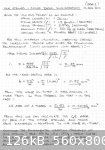
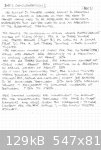
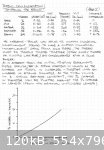
|
|
|
jdowning
Oud Junkie
    
Posts: 3485
Registered: 8-2-2006
Location: Ontario, Canada
Member Is Offline
Mood: No Mood
|
|
Page 2 of the 'Basic Considerations' calculation sheet previously posted has been revised - limiting the plot of % string diameter increase against %
decrease in string length to within 20% and 30% respectively - these likely being the practical limits for strings twisted from silk filament.
The ancient Chinese string makers did not make simply twisted strings for their 'qin' (zither) but made the strings - twisted like little ropes - from
four, independently twisted strand bundles (sometimes three) as previously discussed in this thread. Strings made this way - when fully twisted -
reduce in length by about 25%. From the idealised plot above this would result in a theoretical increase in diameter of about 15% (in practice it
might be a bit more - yet to be verified by experimentation).
This might be just about sufficient to make a Mathna string of the required diameter but not a Mathlath or Bamm string.
The solution used by the ancient Chinese silk string makers to further increase the diameter of their thicker bass strings was to add the necessary
extra material as a winding of silk thread over the twisted core - something like a modern over-spun string - but not quite!
More to follow.
|
|
|
jdowning
Oud Junkie
    
Posts: 3485
Registered: 8-2-2006
Location: Ontario, Canada
Member Is Offline
Mood: No Mood
|
|
Twisting thread bundles according to the thread count given by the Kanz al-Tuhaf does not result in the string diameters required by the
Mersenne-Taylor law in the case of the Mathna, Mathlath and Bamm strings. So, is the information given by the Kanz al-Tuhaf incorrect? Can silk
strings made from the thread bundle counts given by the KAT be made to work satisfactorily according to the Mersenne-Taylor law? The answer is very
likely - yes !
The attached calculation sheets gives the fine detail.
To summarise, the KAT string bundles when twisted to the maximum amount - i.e. assuming a modest 15% increase in diameter from the untwisted string
bundle diameter (to be further confirmed experimentally) - give string diameters of Mathna 0.71 mm, Mathlath 0.87 mm and Bamm 1.00 mm. Compare this to
the required diameters given by the M-T law of 0.79 mm, 1.05 mm, and 1.40 mm respectively.
Solution (A) is to reduce string tension from treble to bass (string density remaining constant at 1.3 gm/cc).
This results in reducing string tension, according to the Mersenne-Taylor relationship, of Mathna
2.9 Kg, Mathlath 2.4 Kg and Bamm 1.8 Kg.
Solution B is to increase string density assuming constant tension. So, from the Mersenne -Taylor relationship, for the Mathna string a density of 1.6
gm/cc is required (23% increase) and for the Mathlath 1.9 gm/cc (46% increase and Bamm 2.6 gm/cc (100% increase).
From previous discussions posted about 'weighting' of silk with Tannin and metallic salts, these density increases should be well within the practical
limits.
Of course, a combination of the (A) and (B) possibilities may be combined to produce any desired result within practical limits.
Next to examine a third possibility - that of adding additional material to a string by over spinning or wrapping a string with silk thread
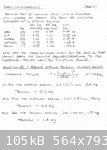
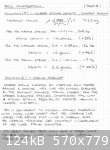
|
|
|
jdowning
Oud Junkie
    
Posts: 3485
Registered: 8-2-2006
Location: Ontario, Canada
Member Is Offline
Mood: No Mood
|
|
The modern metal over spun oud bass strings, familiar to everyone, have cores of nylon filaments wound with wire to provide extra string mass without
loss of string flexibility. Prior to the general availability of nylon in the 1950's, silk filament was used for the string core. A set of oud strings
that I purchased in Cairo as late as the early 60's was comprised of gut trebles and wire over spun on a silk core basses.
The metal over spun string type first became available in the late 17th C. so were not used on ouds before this time (and likely not until much
later).
However, the ancient Chinese made over spun bass strings with a silk core with a silk filament wrapping so it is possible that this type of string may
also have been used on early ouds.
Wire wound over spun strings are made by feeding a soft metal wire onto the string core as it rotates at high speed under tension. An early string
winding apparatus is shown in L'Encyclopedie' (1767) by Denis Diderot among the engravings illustrating 'Lutherie' (Planche XIII). The string is
placed under tension with a weight and rotated at high speed with a hand cranked wheel that drives a hook at one end - the other end being connected
to freely rotating swivel. The operator feeds the wire by hand onto the string (like a spring) as the core rotates.
This is essentially the same method used to make modern over spun strings except that the string core is mounted under tension between two
synchronised hooks rotating together in unison (using an electric motor drive). The more "sophisticated" machines for mass producing strings are
computer controlled with a wire feed carriage that automatically traverses the length of a string at the correct feed rate.
Mimmo Peruffo of Aquila Strings shows how it is done by hand in this video of a visit to the Aquila factory. Go to:
http://www.aquilacorde.com
Click on the FAQ button > Our Gut String Making > Video.
The demonstration is about half way through the video. It looks so easy!
However, this was not the apparatus used by the ancient Chinese silk string makers. More to follow.
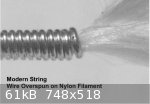

|
|
|
| Pages:
1
2
3
4
5
6
..
13 |